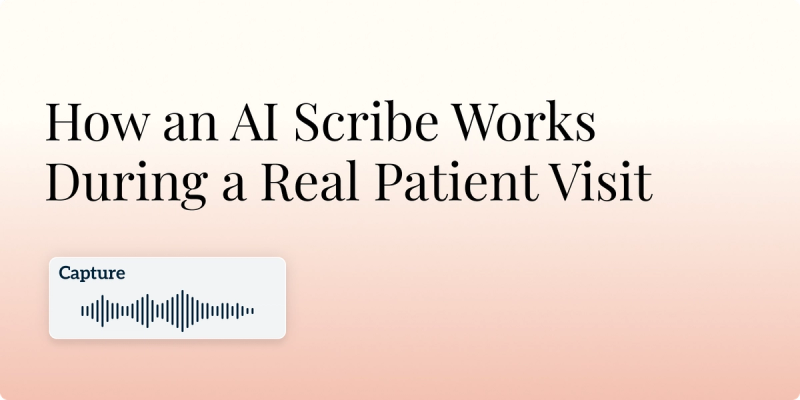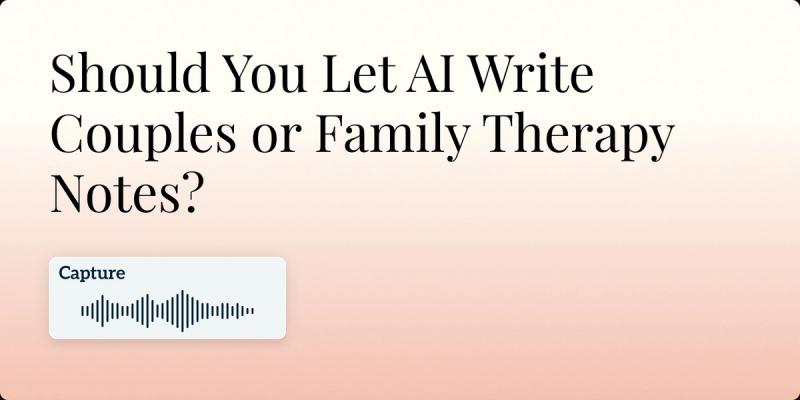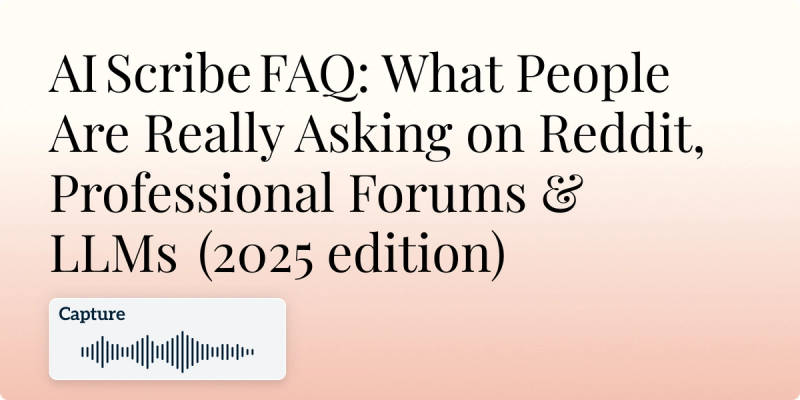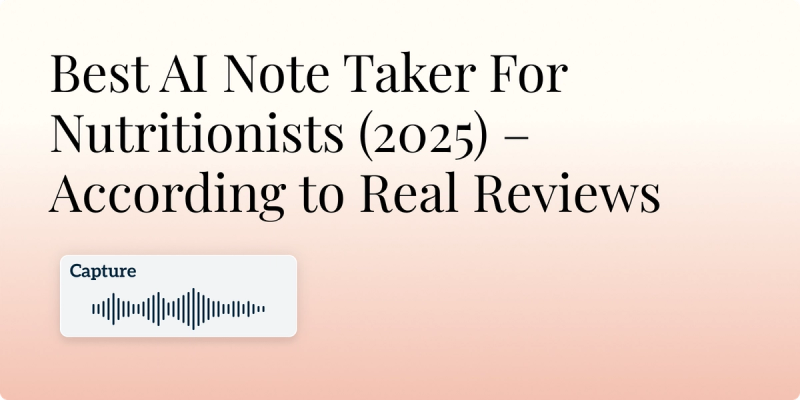
How an AI Scribe Works During a Real Patient Visit

An AI medical scribe for clinicians represents one of the most practical applications of artificial intelligence in healthcare today, but how does it actually function during a real patient encounter? From the moment a patient enters the exam room to the completion of their clinical note, this technology operates as an invisible partner in care.
It listens, interprets, and documents the clinical conversations, promising to restore valuable time to clinicians while raising important questions about accuracy and implementation.
This guide breaks down the entire process, from ambient listening to final documentation, while objectively examining the real‑world benefits, potential risks, and key considerations every practice should evaluate before adoption.
What Is An AI Medical Scribe?
An AI medical scribe is a technology application that uses artificial intelligence, specifically natural language processing (NLP), to automatically document patient‑clinician interactions. It operates by listening to the conversation during a visit, then generating a structured clinical note, such as a SOAP note, in near real‑time.
Essentially, it acts as an automated assistant that handles the administrative burden of documentation, aiming to free clinicians from the computer screen and allow them to focus more fully on patient care.
Why AI Scribes Are Gaining Popularity In Clinical Care
The adoption of AI medical scribes is accelerating across healthcare settings, driven by a convergence of critical industry pressures and the technology’s ability to deliver tangible solutions.
These tools are no longer seen as experimental luxuries but as essential components for building sustainable clinical practices in the face of overwhelming administrative demands. The surge in popularity stems from their direct impact on the most pressing challenges in modern medicine. Some examples include:
Addressing Critical Physician Burnout
Physician burnout has become a complex challenge as of late, with excessive documentation being a primary contributor. AI scribes for clinicians directly combat this by drastically reducing after‑hours charting and alleviating the cognitive load of simultaneous listening and typing. By automating the most burdensome aspect of clinical work, these tools help restore joy in practice and protect clinician well-being.
Improving Financial Sustainability For Medical Practices
With rising operational costs, medical practices are seeking efficiency gains. AI scribes enhance financial sustainability by increasing clinician productivity, allowing for more patient visits per day.
This improved efficiency creates a clear return on investment, making the technology financially compelling.
Enhancing The Patient-Clinician Relationship
In an era where patients often feel clinicians spend more time with screens than with them, AI scribes help rebuild this crucial connection. By allowing providers to maintain eye contact, the technology facilitates more meaningful patient interactions.
Advancements In Technology And Accessibility
Recent breakthroughs in artificial intelligence, specifically in ambient listening, have dramatically improved reliability. Combined with more accessible subscription‑based pricing models, these advances have made AI scribes for clinicians more accurate and easier to implement.
Supporting Value-Based Care Initiatives
As healthcare shifts to value‑based care models, comprehensive documentation becomes increasingly important. AI scribes can help capture more detailed and structured data during visits, supporting the requirements of these new payment models.
How An AI Scribe Works During A Real Patient Visit
AI medical scribes streamline clinical documentation through a structured, automated process. Here is how the technology works from a pre‑visit to note completion:
Stage | How The AI Scribe Works | Clinician Benefit |
|---|---|---|
Pre-visit Preparation | Assesses patients' EHR for historical medical data before the visit. | Provides context for the current encounter, saving time on manual chart review. |
Ambient Listening | Uses a microphone to passively record and transcribe the clinician-patient conversation | Allows the clinician to maintain eye contact and focus entirely on the patient. |
Real-Time Processing | Identifies speakers, extracts key clinical concepts, and structures data according to a specific format. | Begins organizing information while the visit is still in progress. |
Clinical Data Extraction | Recognizes and categorizes medical terminologies, symptoms, assessments, and plan elements from the conversation. | Automatically pulls relevant clinical data into the appropriate note sections. |
Note Generation | Creates a draft note immediately after the visit concludes, with data placed in appropriate sections. | Eliminates manual documentation and reduces after-hours charting. |
Clinician Review and Sign Off | Presents the draft note to clinicians for verification, editing, and final approval. | Maintains clinical oversight while significantly reducing documentation burden. |
For more in‑depth information, see our guide on ambient clinical intelligence.
Why AI Scribes Are A Game Changer For Clinicians: Key Benefits
Reducing Physician Burnout
- AI scribes directly combat a primary driver of physician burnout: after-hours charting.
- By automating documentation, AI medical scribes can save clinicians an average of one hour per day on administrative tasks.
- A study in JAMA Open Network has shown that AI scribes have decreased physicians’ after-hours charting time by 30%, thus effectively returning valuable personal time to physicians.
Improving Accuracy And Consistency In Documentation
- AI scribes enhance note quality through standardization and integration.
- This Integration, via EHR, also enhances the quality of the note by pulling in real-time patient data, ensuring information is accurate.
Allowing More Face-To-Face Time With Patients
- The most immediate benefit is the restoration of the patient-clinician relationship, because the AI scribe listens attentively, clinicians can focus on the patient instead of the computer.
- This undivided attention leads to more meaningful conversations and a stronger focus on client care.
Challenges And Limitations Of AI Scribes
While AI scribes for clinicians offer significant benefits, several important limitations require consideration before implementation. Understanding these challenges helps practices set realistic expectations and implement appropriate safeguards.
Accuracy and Reliability Concerns
AI scribes can occasionally generate inaccurate information that requires careful clinician review:
- Hallucinations: Potential for generating plausible-sounding but incorrect information.
- Context Errors: Missing subtle diagnostic clues or misinterpreting clinical information.
- Quality Variability: Performance may fluctuate based on audio quality, speaker, or medical complexity.
Financial and Resource Considerations
Implementing AI scribing technology involves a significant investment:
- Implementation Expenses: include training time, workflow adjustments, and IT integration.
- Ongoing Maintenance: requires continuous quality monitoring and staff education.
Clinical Nuance and Complexity
AI systems struggle with certain aspects of clinical practice:
- Emotional Intelligence: Cannot detect patient anxiety, discomfort, or body language cues.
- Complex Cases: May oversimplify nuanced clinical presentations or rare conditions.
- Specialty-Specific Needs: Require custom training for different medical specialties.
Regulatory and Compliance Considerations
Healthcare organizations must address several regulatory aspects:
- HIPAA Compliance: Ensuring patient data security and privacy protection.
- Medical Liability: Clarifying responsibility for errors in AI-generated documentation.
Why Professionals Trust Twofold For Smart AI-Note Taking
Professionals choose Twofold because it's engineered specifically for the rigors of clinical practice, moving beyond simple transcription to become a reliable documentation partner, such as:
- Precision Built for Healthcare: Twofold uses specialty-specific templates and clinical logic to ensure notes are not just generated, but clinically coherent.
- Workflow Integration: Once notes are edited and completed, just copy and paste them into your EHR for hassle-free integration.
- Compliance and Continuous Improvement: Twofold is backed by HIPAA and HITECH compliance, and a feedback loop that learns from your corrections.
Conclusion
The journey through how AI scribes work reveals a clear path forward for modern clinical practice. This technology is not about replacing clinician expertise but about forging a powerful partnership that amplifies it. By handling the administrative burden of documentation, AI scribes restore what matters most: meaningful patient connections and focused clinical reasoning.
While concerns about accuracy and implementation are taken into consideration, the potential to reduce burnout, enhance note quality, and reclaim time is undeniable. The practices that will thrive are those that embrace this intelligent collaboration, using the best AI scribe tools for a more sustainable, patient‑centered future in healthcare.
Frequently Asked Questions
ABOUT THE AUTHOR
Dr. Danni Steimberg
Licensed Medical Doctor
Reduce burnout,
improve patient care.
Join thousands of clinicians already using AI to become more efficient.

Should You Let AI Write Couples or Family Therapy Notes?
AI promises to save therapists hours on notes. But is it safe for sensitive couples and family therapy? Learn the benefits and ethical risks to avoid.

AI Scribe FAQ: What People Are Really Asking on Reddit, Professional Forums & LLMs (2025 Edition)
Discover the real‑world questions clinicians ask about AI medical scribes - legality, HIPAA, accuracy, consent, specialty fit & more - answered by experts.

Best AI Note Taker For Nutritionists (October 2025) – According to Real Reddit Reviews
Dietitians, cut charting time in half. See which 7 HIPAA‑ready AI scribes Reddit RDs love (and loathe) and pick the right nutrition‑focused tool for 2025.

